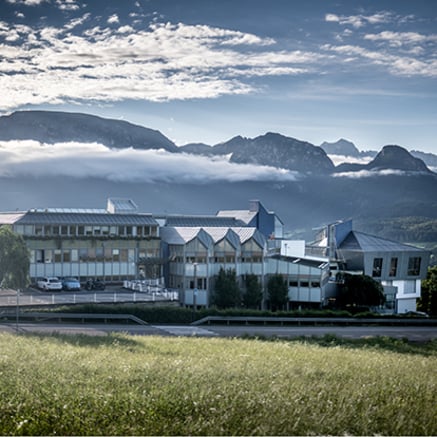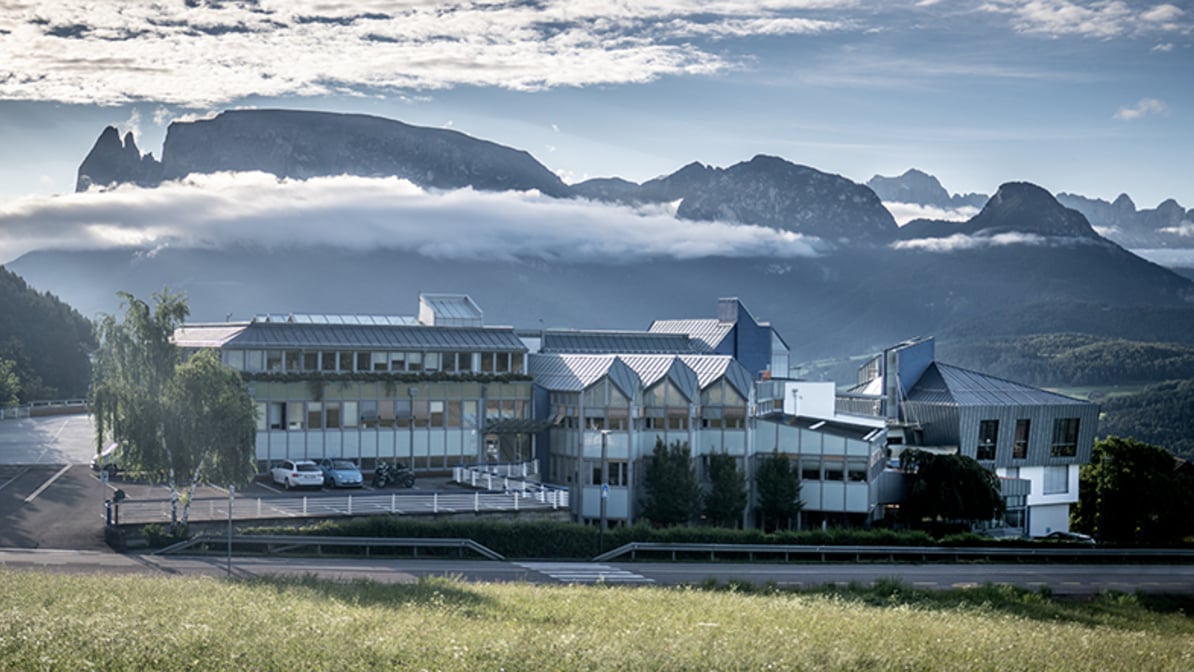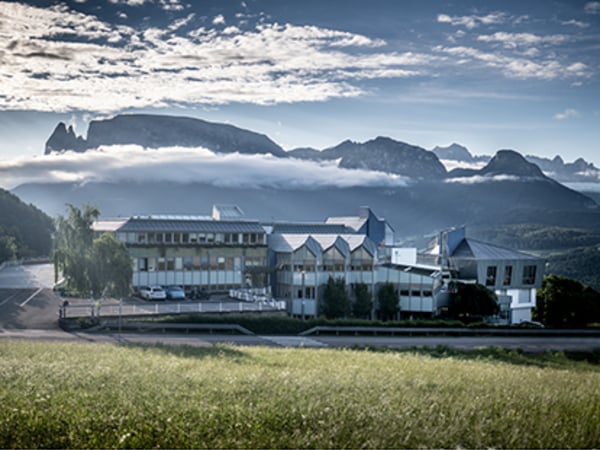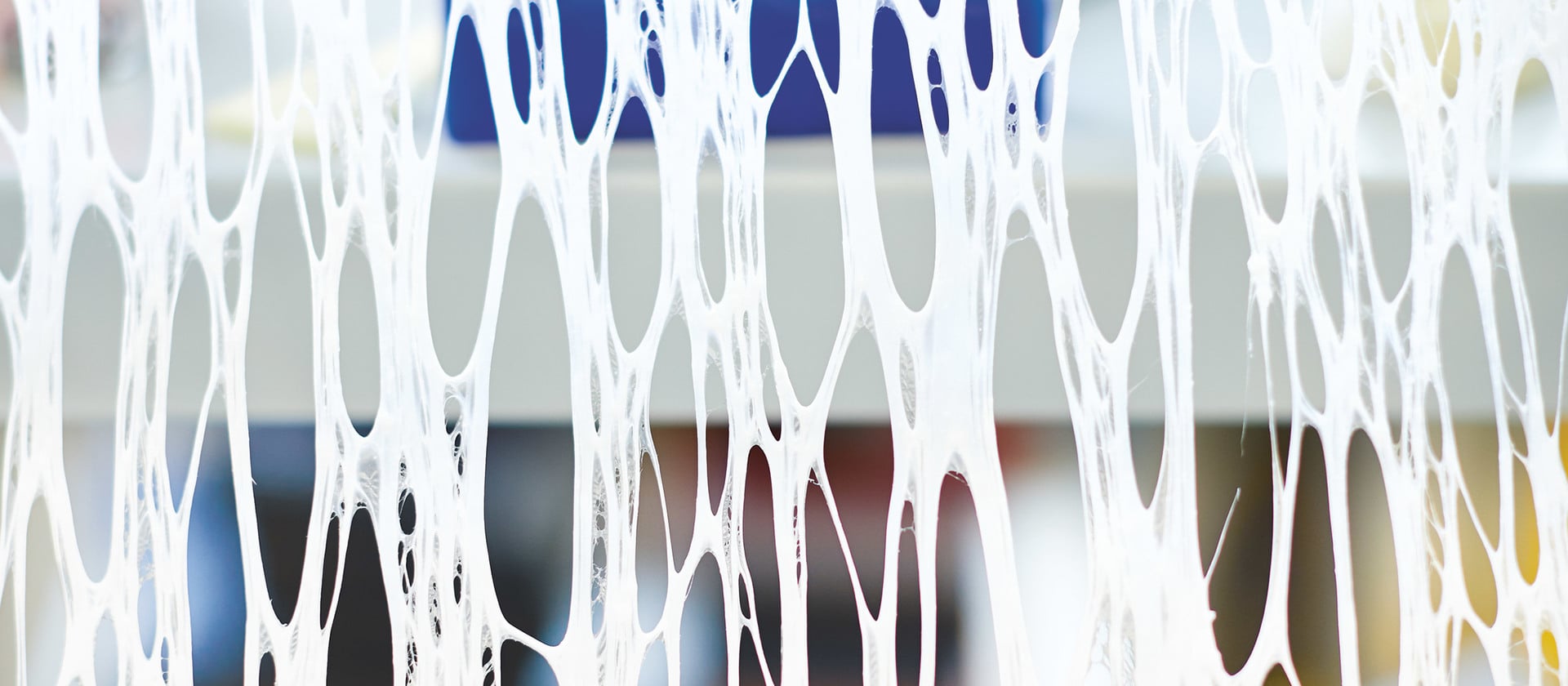
Wonderfully versatile.
An article about the mutual influence and development of plastics and design.
Plastics are what we make of them. That is why the story of their development has always been an exploration of design.
Text: Barbara Teichelmann
It’s a question of colour. “The gaudier the colour, the more likely you are to think of plastic”, says Michael Plank. “Orange, for example, appears rather cheap. Whereas if I choose a subtle beige tone or a dark grey, I cannot immediately recognise the material. It could even be a powder-coated metal. This gives plastic a more abstract, high-quality aesthetic appeal.” That’s why Plank offers many of his chairs, stools and tables not only in standard colours like white, black and grey, but also in pastel lime green, dark red or a warm caramel tone. Now in the third generation, the South Tyrolean Plank company has been building furniture for 65 years. Initially, it was only traditional chairs made of local wood and from its own workshop.
When the price war began in the late 1990s, it became important to differentiate the firm from others, so Plank began to experiment with new, modern forms. This approach has been consistently pursued and today Plank works together with well-known international designers such as the Japanese Naoto Fukasawa, the Italian Claudio Bellini and the German Konstantin Grcic. “Our vision”, says managing director Michael Plank, “was from the very outset to be a design company that looked beyond mass production and set ourselves apart from the competition with an outstanding product.” And that vision has been realised. Most recently, the Land lounge chair by Fukasawa won two US design awards, while Grcic’s Myto cantilever chair and Miura stool have for some time featured in the New York Museum of Modern Art’s collection. Is it a coincidence that the first collaboration with a designer also produced the company’s first uPVC product? “In a way, yes”, recalls Plank. “The design came first, then was materialised by the design process and technical simulations. UPVC was simply the most suitable material, both technologically and economically.”
Text: Barbara Teichelmann
It’s a question of colour. “The gaudier the colour, the more likely you are to think of plastic”, says Michael Plank. “Orange, for example, appears rather cheap. Whereas if I choose a subtle beige tone or a dark grey, I cannot immediately recognise the material. It could even be a powder-coated metal. This gives plastic a more abstract, high-quality aesthetic appeal.” That’s why Plank offers many of his chairs, stools and tables not only in standard colours like white, black and grey, but also in pastel lime green, dark red or a warm caramel tone. Now in the third generation, the South Tyrolean Plank company has been building furniture for 65 years. Initially, it was only traditional chairs made of local wood and from its own workshop.
When the price war began in the late 1990s, it became important to differentiate the firm from others, so Plank began to experiment with new, modern forms. This approach has been consistently pursued and today Plank works together with well-known international designers such as the Japanese Naoto Fukasawa, the Italian Claudio Bellini and the German Konstantin Grcic. “Our vision”, says managing director Michael Plank, “was from the very outset to be a design company that looked beyond mass production and set ourselves apart from the competition with an outstanding product.” And that vision has been realised. Most recently, the Land lounge chair by Fukasawa won two US design awards, while Grcic’s Myto cantilever chair and Miura stool have for some time featured in the New York Museum of Modern Art’s collection. Is it a coincidence that the first collaboration with a designer also produced the company’s first uPVC product? “In a way, yes”, recalls Plank. “The design came first, then was materialised by the design process and technical simulations. UPVC was simply the most suitable material, both technologically and economically.”

Reduced scale: before an idea can take shape, it goes through various stages of realisation. Plank always makes miniature models of all his designs in order to check the statics and proportions.
“Plastic embodies the idea of a material that completely bends to our will and from creatures makes us into creators.”
It’s a question of surface. “Plastics are very versatile. Glossy or matt, rough or smooth – we can apply different surfaces to a material, greatly impacting its effect. This great freedom of design appeals to demanding customers in particular.” Eva Höfli works in BASF’s designfabrik in Ludwigshafen, Germany and is herself a designer advising industrial designers on issues affecting plastic. What are the questions, requirements and expectation involved? “They can vary enormously and it very much depends on whether a chair, a coffee maker or a bicycle saddle is to be produced. But in principle, designers are open to new ideas and like to be inspired.” Like Konstantin Grcic, when he was working on his Myto cantilever chair eleven years ago. At that time, a new engineering polymer emerged from the group of thermoplastics: polybutylene terephthalate.
A forerunner of his now legendary chair is still kept in the designfabrik. When you sit on it you notice that it will slightly sway horizontally. “In this prototype”, Höfli explains, “the material and the statics were not perfectly aligned.” A few metres away, several examples of the Myto can be seen in pale green, bright blue, black and white around a large conference table. There is also a fire-red one. And the surface? It is matt, it feels cool, soft and firm. But it could also be very different, high gloss for example. Höfli sees the fact that plastic does not have any unique characteristics, apart from being highly flexible, as a great advantage – and only in retrospect as a problem: “In the past, considerable effort went into making other materials such as leather or wood look deceptively real. It was cheaper, but it was also regarded as cheap. A table that pretended to be made of wood would be rejected as a material falsehood. Anyone working with plastics today is happy to admit it and will try to improve the surface quality so that it has a high-quality appearance and is pleasant to the touch.”
When Prof. Christian Bonten wants to introduce his students to the ubiquitous, matter-of-course nature of plastic, he likes to start with a shampoo bottle. It is something that everyone knows and uses. “Look at it, it’s light, it’s unbreakable, pleasant to the touch, colourful, it can be printed and labelled and comes in many different shapes and sizes. The lid even has a small hinge that can be clipped open or closed.” He then mentions the less obvious but, from an engineering point of view, critical advantage: cheap mass production combined with low energy and resource requirements. “Compared to glass or metal products, the ecological balance sheet of plastics is still unbeatable. Only paper bags can perform as well.” But paper is not much use for shampoo.
Bonten is an engineer, an honorary vice-president of the German Plastics Museum and heads the Institute of Plastics Engineering at the University of Stuttgart. He is constantly amazed that people consider plastic to be a cheap material. “One kilogram of plastic costs more than a kilogram of steel. It is not the material itself that is cheap, but rather its production, because it consumes so little energy. The great thing about plastic is its production technology.” With all the advantages and disadvantages that mass production entails. It is not the material itself that is the problem, but rather our way of dealing with it. “Who throws plastic waste into the oceans? We do.” That’s why Bonten is calling for a radical rethink: “Why do we allow products that are as short-lived as straws, stirrers or plastic bags? We have to think about the applications that plastics are really suitable for. And we have to change our behaviour. Designers especially can help, as they are close to the consumer.”
It is significant that you get very different answers depending on who you ask about the most important benefits of plastic. Furniture manufacturers, chemical companies, engineers – everyone emphasises the aspect that matters most to them. And designers? All of the advantages are important to them. Or rather, the possibilities that can be made of them. Plastic has always been more than just a material. Plastic embodies the idea of a material that completely bends to our will and from creatures makes us into creators. Of course, even before plastic existed there were materials that did not occur in that form in nature and that we virtually invented by combining different materials, such as glass, ceramics or cast iron. But none of them was so radically versatile or so radically malleable. In 1902, the Belgian-Flemish architect and designer Henry van de Velde prophesied: “Our dream of a flexible material that follows our intentions as easily as the language of our thoughts will come true.” It turned out that that material was plastic. At first only theoretically, because the manufacturing processes were initially lacking. But the potential was already tangible, even several hundred years ago.
It is true that plastic is a relatively recent material and a child of industrialisation. But the principle of transformation was recognised much earlier. In 1530 the Swiss merchant Bartholomäus Schobinger and the Bavarian Benedictine monk Wolfgang Seidel experimented with goat’s cheese to create a “transparent material” that reminded them of a “beautiful horn”. The notes of the two inventors contain the oldest preserved recipe in German for a plastic material and a short prophecy: “[...] if it has been made right, it can be used to cast table tops, tableware and medallions, in other words anything you want.” So there it was, the material that made everything possible. These first plastics, made of casein, were a substitute for natural horn and were further developed into Galalith towards the end of the 19th century. At that time, many new materials were produced worldwide, for example hard rubber, artificial silk and silicones. Celluloid too was patented at that time and, as a cheap imitation for ivory or tortoise-shell, was made into decorative combs, picture frames and umbrella handles. At the beginning of the 20th century, Bakelite was followed by the first fully synthetic and industrially produced plastic, a polymer of phenol and formaldehyde. It too was mostly used as a substitute for wood as well as for gemstones.
It’s a question of surface. “Plastics are very versatile. Glossy or matt, rough or smooth – we can apply different surfaces to a material, greatly impacting its effect. This great freedom of design appeals to demanding customers in particular.” Eva Höfli works in BASF’s designfabrik in Ludwigshafen, Germany and is herself a designer advising industrial designers on issues affecting plastic. What are the questions, requirements and expectation involved? “They can vary enormously and it very much depends on whether a chair, a coffee maker or a bicycle saddle is to be produced. But in principle, designers are open to new ideas and like to be inspired.” Like Konstantin Grcic, when he was working on his Myto cantilever chair eleven years ago. At that time, a new engineering polymer emerged from the group of thermoplastics: polybutylene terephthalate.
A forerunner of his now legendary chair is still kept in the designfabrik. When you sit on it you notice that it will slightly sway horizontally. “In this prototype”, Höfli explains, “the material and the statics were not perfectly aligned.” A few metres away, several examples of the Myto can be seen in pale green, bright blue, black and white around a large conference table. There is also a fire-red one. And the surface? It is matt, it feels cool, soft and firm. But it could also be very different, high gloss for example. Höfli sees the fact that plastic does not have any unique characteristics, apart from being highly flexible, as a great advantage – and only in retrospect as a problem: “In the past, considerable effort went into making other materials such as leather or wood look deceptively real. It was cheaper, but it was also regarded as cheap. A table that pretended to be made of wood would be rejected as a material falsehood. Anyone working with plastics today is happy to admit it and will try to improve the surface quality so that it has a high-quality appearance and is pleasant to the touch.”
When Prof. Christian Bonten wants to introduce his students to the ubiquitous, matter-of-course nature of plastic, he likes to start with a shampoo bottle. It is something that everyone knows and uses. “Look at it, it’s light, it’s unbreakable, pleasant to the touch, colourful, it can be printed and labelled and comes in many different shapes and sizes. The lid even has a small hinge that can be clipped open or closed.” He then mentions the less obvious but, from an engineering point of view, critical advantage: cheap mass production combined with low energy and resource requirements. “Compared to glass or metal products, the ecological balance sheet of plastics is still unbeatable. Only paper bags can perform as well.” But paper is not much use for shampoo.
Bonten is an engineer, an honorary vice-president of the German Plastics Museum and heads the Institute of Plastics Engineering at the University of Stuttgart. He is constantly amazed that people consider plastic to be a cheap material. “One kilogram of plastic costs more than a kilogram of steel. It is not the material itself that is cheap, but rather its production, because it consumes so little energy. The great thing about plastic is its production technology.” With all the advantages and disadvantages that mass production entails. It is not the material itself that is the problem, but rather our way of dealing with it. “Who throws plastic waste into the oceans? We do.” That’s why Bonten is calling for a radical rethink: “Why do we allow products that are as short-lived as straws, stirrers or plastic bags? We have to think about the applications that plastics are really suitable for. And we have to change our behaviour. Designers especially can help, as they are close to the consumer.”
It is significant that you get very different answers depending on who you ask about the most important benefits of plastic. Furniture manufacturers, chemical companies, engineers – everyone emphasises the aspect that matters most to them. And designers? All of the advantages are important to them. Or rather, the possibilities that can be made of them. Plastic has always been more than just a material. Plastic embodies the idea of a material that completely bends to our will and from creatures makes us into creators. Of course, even before plastic existed there were materials that did not occur in that form in nature and that we virtually invented by combining different materials, such as glass, ceramics or cast iron. But none of them was so radically versatile or so radically malleable. In 1902, the Belgian-Flemish architect and designer Henry van de Velde prophesied: “Our dream of a flexible material that follows our intentions as easily as the language of our thoughts will come true.” It turned out that that material was plastic. At first only theoretically, because the manufacturing processes were initially lacking. But the potential was already tangible, even several hundred years ago.
It is true that plastic is a relatively recent material and a child of industrialisation. But the principle of transformation was recognised much earlier. In 1530 the Swiss merchant Bartholomäus Schobinger and the Bavarian Benedictine monk Wolfgang Seidel experimented with goat’s cheese to create a “transparent material” that reminded them of a “beautiful horn”. The notes of the two inventors contain the oldest preserved recipe in German for a plastic material and a short prophecy: “[...] if it has been made right, it can be used to cast table tops, tableware and medallions, in other words anything you want.” So there it was, the material that made everything possible. These first plastics, made of casein, were a substitute for natural horn and were further developed into Galalith towards the end of the 19th century. At that time, many new materials were produced worldwide, for example hard rubber, artificial silk and silicones. Celluloid too was patented at that time and, as a cheap imitation for ivory or tortoise-shell, was made into decorative combs, picture frames and umbrella handles. At the beginning of the 20th century, Bakelite was followed by the first fully synthetic and industrially produced plastic, a polymer of phenol and formaldehyde. It too was mostly used as a substitute for wood as well as for gemstones.
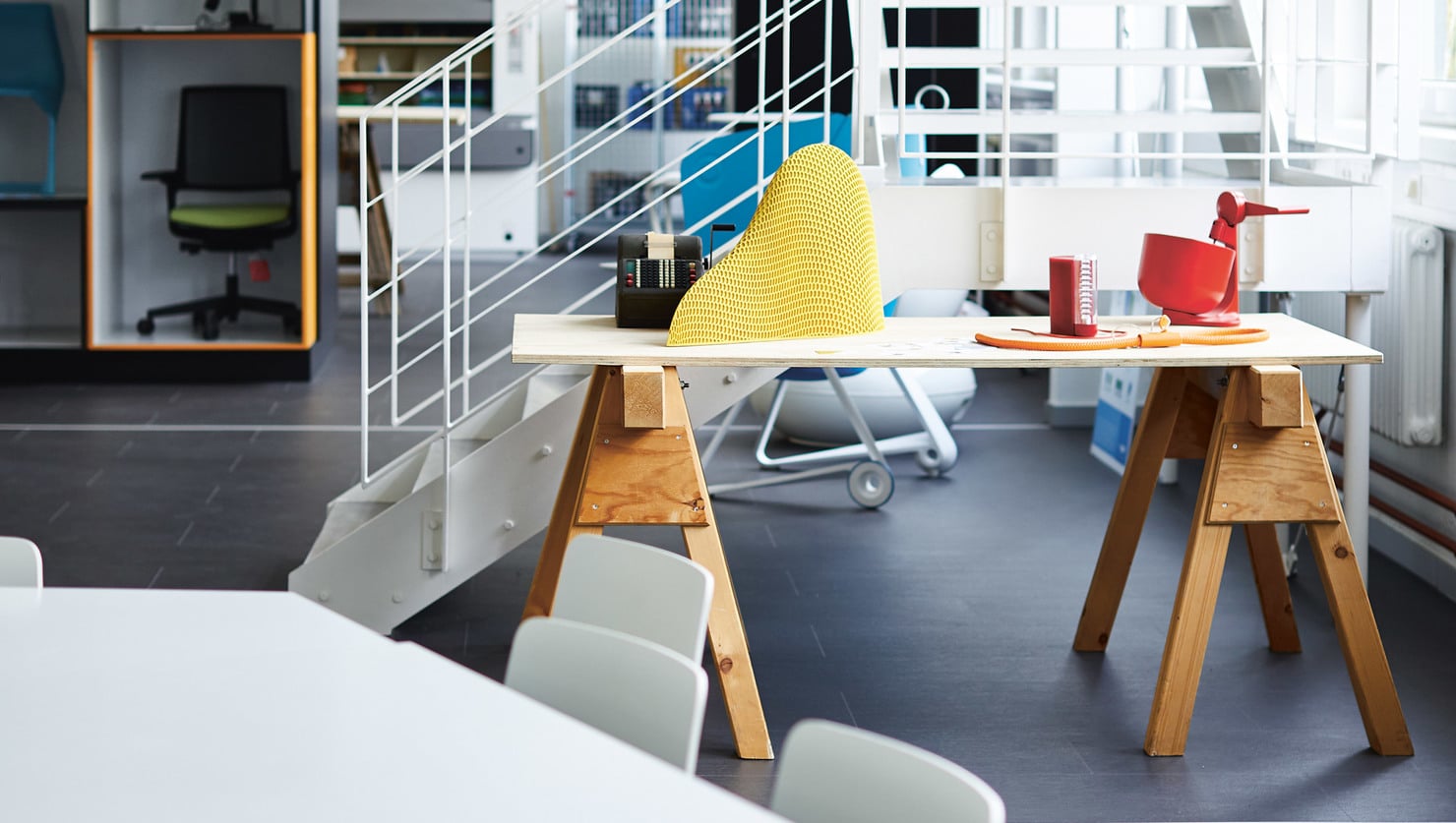
From kitchenware to bike saddles. For twelve years now, the BASF designfabrik in Ludwigshafen has been advising designers on the subject of plastics.

Translating form into material: in the BASF designfabrik Eva Höfli advises designers on choosing the right plastic.
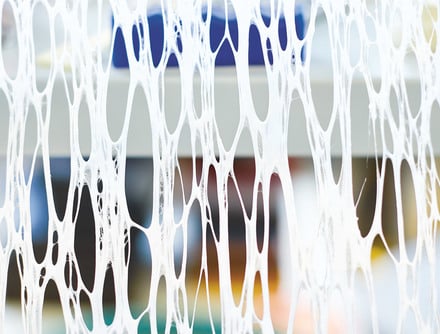
Inspiration through chance: unplanned plastic mutations are collected in the BASF designfabrik. And sometimes they can be used in a new product.
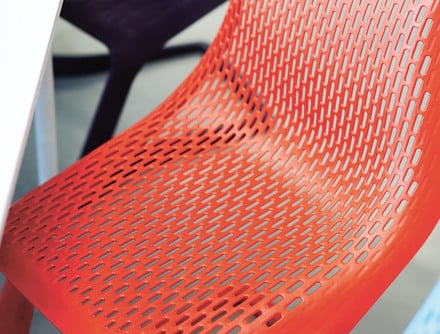
Plastics are what we make of them. That is why the story of their development has always been an exploration of design.

Making designer furniture from ideas: Michael Plank represents the third generation to run the South Tyrolean Plank company.
Plastic had to fight long and hard against the fact that it could be easily mutated. It was accused of having no character. For example, the German-Bohemian art historian Gustav Pazaurek in his 1909 essay, “System of artistic perversions”, opens a chapter on the subject of “material surrogates” and mentions celluloid and Galalith as material perversions if they simply pretend to be other materials. What was not genuine or did not at least seek the truth was inferior and wrong. After all, the opposite of the truth is a lie, or at least intentional deception. The objects that were encountered in everyday life should also adhere to a basic moral code. In addition, at the turn of the century arts and crafts were fundamentally perceived as being tastelessly overloaded, as an anachronistic ornamentation seeking to imitate the luxury goods of the wealthy.
People thus sought to reduce matters to the essential, with a consequent return to function, form and material. In 1907 van de Velde founded the Grand Ducal Saxon School of Applied Arts in Weimar, which became the nucleus of the Bauhaus movement. Wood, metal or textiles – the architect and Bauhaus founder Walter Gropius divided craft classes according to the materials used. There was no class for synthetic or plastic materials. There was however much talk of “truth of materials”. Wood should not be concealed or processed beyond recognition, but rather made visible and tangible. What could be done with a material that did not exist in natural form and did not speak a clear truth? Plastic simply jabbered back what was said to it. This absence of any aesthetic of its own challenged the material canon. What was now “authentic”? And was authenticity still a valid category? If it was the case that there is a truth in every material, then the truth of plastic would change with each requirement placed on it. It could be light or heavy, sturdy, fragile or flexible, delicate or chunky, fireproof and acid resistant. Each application called for the redefining of a new truth. This was at the same time both exhausting and appealing, a challenge to the chemists and a guarantee that plastic would constantly change and develop.
And yet it was the architects, designers and artists who were neither intimidated nor unwilling to switch their views from left to right. They turned the reactions from negative to positive and started to play around with the possibilities. They experimented with form, colour and effect – and wer delighted to see that plastic adapted to any idea and willingly took on whatever shape it was given. Suddenly it was no longer necessary to think, plan and produce within the limits of the material. Now the challenge was different: it was a matter of coping with the enormous freedom and extracting something concrete from it. A completely new formal idiom, for example.
In 1946 the Finnish architect Eero Saarinen designed his famous “Womb Chair”, whose curved plastic shell consists of a fibreglass-reinforce polyester resin that had been developed during the Second World War. As the material was supposedly so unattractive he hid it under a fabric cover. But plastic was not to be stopped. Just two years later, the American designer couple Charles and Ray Eames took part in the Museum of Modern Art’s “International Competition for Low-Cost Furniture Design”, presenting their Side Chair DSW with its wooden base frame, whose fibreglass-reinforced polyester seat pan confidently announced a new aesthetics. The message was clear: Hey, I’m made of plastic and that’s OK. Both chairs became design classics and made plastic socially acceptable by leaving the conventional behind and proclaiming a modern, international style of materials. And a new design that was organically arched and showed off its curves. This was also due to the production process, as sharp edges are difficult to reproduce in both the injection moulding process and in pressing, transfer moulding, casting and blow moulding.
Strictly speaking, this was again a case of the truth of a material with its own formal idiom being found, one which was only possible with this material. This dynamic line layout was most spectacularly realised by the Danish designer and architect Verner Panton in the 1960s. His Panton Chair cites the ergonomic shape of the seated body and is the first all-plastic chair made in one piece. If you sit on it, it is an item of seating, while if it stands free and by itself it becomes a sculptural body in the room.
It almost seemed as if the old struggle between function and aesthetics had been decided in favour of both sides. People stopped sorting and using materials according to their aesthetic and functional origins. Chairs had long been made solely of wood. But so what? From now on a chair was no longer automatically better or more authentic just because it was made of wood. People exchanged tradition for curiosity and wondered what would happen next. An idea was thrown into the room and would take shape. Everything seemed possible. For a short while they enthusiastically held to the illusion that a material without properties was also a material without original sin; a material that can do anything and demands nothing. This was helped by the economic miracle, which was to a certain extent also a plastic miracle. In 1950, 1.5 million tonnes of plastic were produced worldwide; in 1977 this figure was 50 million tonnes and by 1989 it was 100 million tonnes. A trend that has continued to rise strongly. In 2016, as documented by Plastics Europe, the Association of European Plastic Manufacturers, 335 million tonnes were produced worldwide. A trend that is still rising.
Plastics have meanwhile conquered absolutely every area of our lives: packaging, medicine, vehicles, construction, household goods, furniture, farming... and, in the individual sectors, ever new areas appear in which plastics can take on yet more tasks, such as in the automotive industry or in space travel. The finite nature of the fossil raw materials that have until now been mostly used for plastics production is above all a cost problem. For years people have been working with carbons from renewable sources that work just as well, but are more expensive. A 2016 study by the Institute for Bioplastics and Biocompositess (IfBB) puts the share of bioplastics in the global plastics market at just six percent. It is estimated that this share will increase to at least ten percent in the next five years. An indication of how great our expectations were of plastic and how irrational is our relationship with it can be seen from the fact that we are yet to forgive it for ageing. For a long time, no patina was allowed to form on it. Plastic was supposed to stay forever young, beautiful and colour-fast. People were almost offended, turning their backs on it and refusing to accept that an artificial material too is mortal. So it was back to the genuine article. But it had long become clear that the future would be made of plastic. And so it experienced its ups and downs, was sometimes more and sometimes less of a presence, but it has never gone away. Plastic is in any case an indispensable part of design history. We could even say that plastic and modern design were mutually dependent – and that still applies today. While the initial unbridled enthusiasm has given way to a more refined, realistic relationship, there is still a consensus in the world of design that plastic is often the best material. At the beginning there is still an idea. But then there is a vast number of pragmatic requirements, from A for amount ordered or P for price range, to V for volume and Z for zero emissions. Industrial design is always subject to the need to be profitable. No problem, as long as you think in large numbers. Working with plastics means investing a lot in the purchase of tools, but not so much in ongoing production.
Reduced scale: before an idea can take shape, it goes through various stages of realisation. Plank always makes miniature models of all his designs in order to check the statics and proportions.
“Plastic,” says Eva Höfli, “is a material that is suitable for mass production. Depending on the requirements, it is quite a challenge to match the shape and construction so that the statics are right. To make sure that the desired properties such as feel, surface quality and colour are all achieved, it is vital to select the right material. But once it is all working and the tool is ready for production, you can produce high-quality plastics at very low running costs.” And the more care that is taken in selecting the material, setting up the production process and the processing quality, the better the result. The fact that plastic per se is a cheap material was the wrong conclusion, because too much had been made too cheaply from cheap material. And once again our first reaction was irrational. When the waste mountains became so high that they blocked our view and the sea washed up plastic bags instead of jellyfish onto the beaches, we blamed the material. We at first ignored the fact that we had for years been throwing plastic bags away in their millions. Reactions are nowadays more differentiated and people are considering where and how they can do without plastic. How the plastic waste mountains can be properly recycled. And what plastic is suitable for as a material. Considering that a high-quality plastic chair will last at least as long as a high-quality wooden chair, if not longer, and can then be 100 percent recycled, there are a lot of benefits to be seen.
Cars, toothbrushes, artificial hip joints, thermal insulation products, tennis rackets, LCD flat screens, breathable rainwear, shoe heels, beer crates... plastic can do anything. Yet plastic can’t do anything. And maybe that’s why plastic is the most authentic material of all. Because plastic does not lie. Plastic mercilessly reflects us and how much or how little energy, love and understanding we put into it. It is not the plastic bag that is stupid, but we as the ones who mass-produce, consume and then throw them away. It is not the chair that is intelligent, but our idea of an attractive, functional and durable item of seating furniture.
People thus sought to reduce matters to the essential, with a consequent return to function, form and material. In 1907 van de Velde founded the Grand Ducal Saxon School of Applied Arts in Weimar, which became the nucleus of the Bauhaus movement. Wood, metal or textiles – the architect and Bauhaus founder Walter Gropius divided craft classes according to the materials used. There was no class for synthetic or plastic materials. There was however much talk of “truth of materials”. Wood should not be concealed or processed beyond recognition, but rather made visible and tangible. What could be done with a material that did not exist in natural form and did not speak a clear truth? Plastic simply jabbered back what was said to it. This absence of any aesthetic of its own challenged the material canon. What was now “authentic”? And was authenticity still a valid category? If it was the case that there is a truth in every material, then the truth of plastic would change with each requirement placed on it. It could be light or heavy, sturdy, fragile or flexible, delicate or chunky, fireproof and acid resistant. Each application called for the redefining of a new truth. This was at the same time both exhausting and appealing, a challenge to the chemists and a guarantee that plastic would constantly change and develop.
And yet it was the architects, designers and artists who were neither intimidated nor unwilling to switch their views from left to right. They turned the reactions from negative to positive and started to play around with the possibilities. They experimented with form, colour and effect – and wer delighted to see that plastic adapted to any idea and willingly took on whatever shape it was given. Suddenly it was no longer necessary to think, plan and produce within the limits of the material. Now the challenge was different: it was a matter of coping with the enormous freedom and extracting something concrete from it. A completely new formal idiom, for example.
In 1946 the Finnish architect Eero Saarinen designed his famous “Womb Chair”, whose curved plastic shell consists of a fibreglass-reinforce polyester resin that had been developed during the Second World War. As the material was supposedly so unattractive he hid it under a fabric cover. But plastic was not to be stopped. Just two years later, the American designer couple Charles and Ray Eames took part in the Museum of Modern Art’s “International Competition for Low-Cost Furniture Design”, presenting their Side Chair DSW with its wooden base frame, whose fibreglass-reinforced polyester seat pan confidently announced a new aesthetics. The message was clear: Hey, I’m made of plastic and that’s OK. Both chairs became design classics and made plastic socially acceptable by leaving the conventional behind and proclaiming a modern, international style of materials. And a new design that was organically arched and showed off its curves. This was also due to the production process, as sharp edges are difficult to reproduce in both the injection moulding process and in pressing, transfer moulding, casting and blow moulding.
Strictly speaking, this was again a case of the truth of a material with its own formal idiom being found, one which was only possible with this material. This dynamic line layout was most spectacularly realised by the Danish designer and architect Verner Panton in the 1960s. His Panton Chair cites the ergonomic shape of the seated body and is the first all-plastic chair made in one piece. If you sit on it, it is an item of seating, while if it stands free and by itself it becomes a sculptural body in the room.
It almost seemed as if the old struggle between function and aesthetics had been decided in favour of both sides. People stopped sorting and using materials according to their aesthetic and functional origins. Chairs had long been made solely of wood. But so what? From now on a chair was no longer automatically better or more authentic just because it was made of wood. People exchanged tradition for curiosity and wondered what would happen next. An idea was thrown into the room and would take shape. Everything seemed possible. For a short while they enthusiastically held to the illusion that a material without properties was also a material without original sin; a material that can do anything and demands nothing. This was helped by the economic miracle, which was to a certain extent also a plastic miracle. In 1950, 1.5 million tonnes of plastic were produced worldwide; in 1977 this figure was 50 million tonnes and by 1989 it was 100 million tonnes. A trend that has continued to rise strongly. In 2016, as documented by Plastics Europe, the Association of European Plastic Manufacturers, 335 million tonnes were produced worldwide. A trend that is still rising.
Plastics have meanwhile conquered absolutely every area of our lives: packaging, medicine, vehicles, construction, household goods, furniture, farming... and, in the individual sectors, ever new areas appear in which plastics can take on yet more tasks, such as in the automotive industry or in space travel. The finite nature of the fossil raw materials that have until now been mostly used for plastics production is above all a cost problem. For years people have been working with carbons from renewable sources that work just as well, but are more expensive. A 2016 study by the Institute for Bioplastics and Biocompositess (IfBB) puts the share of bioplastics in the global plastics market at just six percent. It is estimated that this share will increase to at least ten percent in the next five years. An indication of how great our expectations were of plastic and how irrational is our relationship with it can be seen from the fact that we are yet to forgive it for ageing. For a long time, no patina was allowed to form on it. Plastic was supposed to stay forever young, beautiful and colour-fast. People were almost offended, turning their backs on it and refusing to accept that an artificial material too is mortal. So it was back to the genuine article. But it had long become clear that the future would be made of plastic. And so it experienced its ups and downs, was sometimes more and sometimes less of a presence, but it has never gone away. Plastic is in any case an indispensable part of design history. We could even say that plastic and modern design were mutually dependent – and that still applies today. While the initial unbridled enthusiasm has given way to a more refined, realistic relationship, there is still a consensus in the world of design that plastic is often the best material. At the beginning there is still an idea. But then there is a vast number of pragmatic requirements, from A for amount ordered or P for price range, to V for volume and Z for zero emissions. Industrial design is always subject to the need to be profitable. No problem, as long as you think in large numbers. Working with plastics means investing a lot in the purchase of tools, but not so much in ongoing production.
Reduced scale: before an idea can take shape, it goes through various stages of realisation. Plank always makes miniature models of all his designs in order to check the statics and proportions.
“Plastic,” says Eva Höfli, “is a material that is suitable for mass production. Depending on the requirements, it is quite a challenge to match the shape and construction so that the statics are right. To make sure that the desired properties such as feel, surface quality and colour are all achieved, it is vital to select the right material. But once it is all working and the tool is ready for production, you can produce high-quality plastics at very low running costs.” And the more care that is taken in selecting the material, setting up the production process and the processing quality, the better the result. The fact that plastic per se is a cheap material was the wrong conclusion, because too much had been made too cheaply from cheap material. And once again our first reaction was irrational. When the waste mountains became so high that they blocked our view and the sea washed up plastic bags instead of jellyfish onto the beaches, we blamed the material. We at first ignored the fact that we had for years been throwing plastic bags away in their millions. Reactions are nowadays more differentiated and people are considering where and how they can do without plastic. How the plastic waste mountains can be properly recycled. And what plastic is suitable for as a material. Considering that a high-quality plastic chair will last at least as long as a high-quality wooden chair, if not longer, and can then be 100 percent recycled, there are a lot of benefits to be seen.
Cars, toothbrushes, artificial hip joints, thermal insulation products, tennis rackets, LCD flat screens, breathable rainwear, shoe heels, beer crates... plastic can do anything. Yet plastic can’t do anything. And maybe that’s why plastic is the most authentic material of all. Because plastic does not lie. Plastic mercilessly reflects us and how much or how little energy, love and understanding we put into it. It is not the plastic bag that is stupid, but we as the ones who mass-produce, consume and then throw them away. It is not the chair that is intelligent, but our idea of an attractive, functional and durable item of seating furniture.
Still want more?
See here for further interesting reading matter.


Department of Gestaltungslehre and Design – Technical University of Vienna.
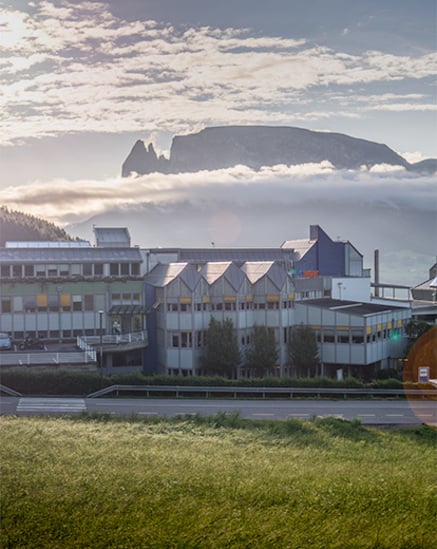
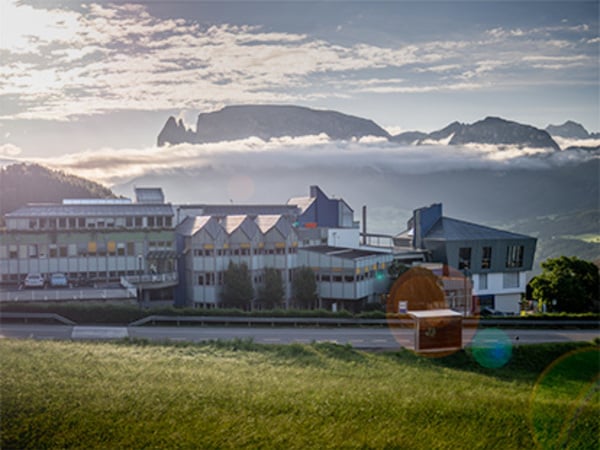
The South-Tyrolean family business is among the biggest window suppliers in Europe.
